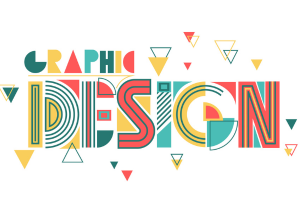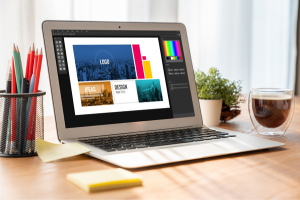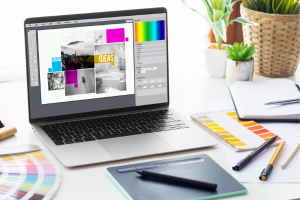A compelling visual identity is not just a luxury today but a necessity in an extremely competitive digital ecosystem to distinguish your brand from clutter, to create an emotional connection with your audience, and to create an identity across platforms. Consumers are becoming design-conscious and are looking forward to a seamless experience with brands that is visually cohesive as they approach 2025. What about a good visual identity that aligns with your brand goals, values, and audience?
This article will take you through all the cutting-edge strategies and design tips for the future of creating memorable visual identities for your brand in 2025, for the essentials.

What Is Visual Identity?
By definition, everything that you can put together to convey the personality value of a trademark, like a logo, color palette, typography, and imagery, is all-inclusive of what visual identity means. What you have just signified is a unique look and feel that consumers have in regards to your brand.
That’s not to say only aesthetics; visual identity builds familiarity and trust. A brand comes to recognition in memory, whether one catches the post on social media, visits the website, or explores the package on the shelf, defining the difference to the consumer in choosing amid a huge clutter.
Why Visual Identity Matters in 2025
Today, they will still do this, but this time in several different ways. That’s why effective investment in a solid visual identity for this year is significant.
Brand recognition hot on the heels of the moment: Your audience will qualify bids instantaneously based on visual assumptions about what your image looks like. Having a strong visual identity ensures that you get recognized in that nanosecond.
Across-the-Board Consistency: The websites, social media accounts, and mobile apps all share a unified visual identity that falls under your brand.
Emotional Connection: Design invokes sentiment. The right images will allow your audience to establish a stronger bond with your brand and entangle their trust, and inspire.
Competition Differentiation: In a digital landscape flooded with content, distinct visual branding helps you rise above the noise.
Step-by-Step Guide to Building a Strong Visual Identity
1. Define Your Brand’s Core Identity
What are the brand values? What is the name given to the particular mission and vision? Who are these people asking these strange questions of your audience? What tone and personality do you want to convey? Ask those questions before you start doing anything with visuals.
That all depends on how you draft or design your logo, from how you choose pictures to everything you do.
2. Create a Memorable Logo
Most importantly, your mark stays the vault in visual priorities. It should be a simple, multipurpose, and ever-enduring bedrock. Minimalist, responsive, and iconic, it should tick the boxes for a logo that works digitally and offline-at least it will for 2025 logo design trends.
Here are some tips:
Pick an appropriate form of logo for your brand-whether it is a wordmark, an icon, an emblem, or a combination mark.
How easy is it to read the text on all scales: it should work for everything, from an app icon to a billboard?
Relevant but not trendy (you want longevity) is the feel of the design.
3. Select a Consistent Color Palette
Colors are moody-word energies, and an actual color palette upholds both mood and feeling while serving to broaden recognition within a brand.
Among the color trends in 2025 are earthen neutrals, futuristic neons, and gradients produced with the help of AI, but even more than those top-of-the-line defects, consistency proves to be key.
Pro tip:
Establish a primary palette (2 to 3 core colors) and a secondary palette (supporting shades). Also, ensure that all colors are accessible, not failing WCAG contrast standards for readability.
4. Define Your Typography
Fonts are usually characterized by personality. Your typography should be modern and slick, bold and expressive, or classic and professional to fit your brand personality.
One or two font families (headlines and body text) to choose from.
It should be readable on every device and even on all screen sizes.
Stay within 2-3 typefaces to be consistent.
Variable fonts and adaptive types will become standards by 2025, especially for responsive design systems.
5. Craft a Unique Visual Language
The visual identity of your brand should stretch beyond mere logos and colors; a real visual language should be upheld:
Iconography: Adopt a uniform style in icons (line style, filled style, isometric, etc.).
Patterns and Shapes: Inject customized graphics reinforcing the personality of the brand.
Photography/Illustration Style: Agree to look for image cohesion, such as warm lifestyle photos, flat vector illustration, etc.
This visual toolkit can be used across your website, packages, advertisements, and social media.
6. Build a Design System or Brand Style Guide
A style guide is essential in maintaining consistency across all platforms and team members. By 2025, brands will be adopting modular design systems that can work in line with technology.
Consider including:
Logo usage rules
Color codes and permutations
Hierarchy of typography
Usage of images and icons
Layout and grid systems
Dos and Don’ts
This will guarantee the scaling of visual identity without losing cohesiveness.
7. Make It Digital-First
Focus on the digital since maximum interaction with your brand occurs online.
Look out for:
Ensure your logo and icons render sharply on high-res (Retina) screens
Designs that work in dark mode
Add some motion graphics and micro-interactions for user enchantment
8. Use AI and Automation to Enhance Consistency
As of 2025, AI tools help maintain a brand’s visual identity at scale. Make them work for you:
Auto-generate social media templates in style
Visuals resizing for platforms
A/B color/ layout test
Use visual consistency checks online.
Automation helps save time and protects against brand infringement.
9. Test and Get Feedback
Solicit input from actual users, team members, and even stakeholders to hone in on your design elements.
Ideas to consider:
Conducting brand perception surveys
Tracking visual elements with analytics to see what engages
User feedback validates that your identity works for your brand and its people.
10. Evolve Without Losing Consistency
Do not chicken away of evolution even if staying in line is very important. Obscured logos will be outdated within a few years, and the strongest brands will be searching for relevance without minimizing their real character.
Among several other measures, consider:
Refreshing the palette or typography system, but keeping the logo intact.
Illustrations or iconography metamorphosis about the brand’s growth
Employing some visual changes for seasonal or campaign purposes
The idea is to keep evolving while securing the maximum probability of knowing you.
Conclusion
A safe visual identity is yet another form of attractive design; it becomes an identity-given strategic asset to brand awareness, trust, and customer loyalty. In 2025, the need for flexible yet consistent identity construction will be mandatory due to rising AI, hyper-personalization, and cross-platform engagement.
When addressing the brand of a start-up or commemorating an established brand, put your heart and dedication behind a visual system developed with authenticity, scalability, and emotional connectivity in mind. With some thought, your visual identity will grab and hold attention.






